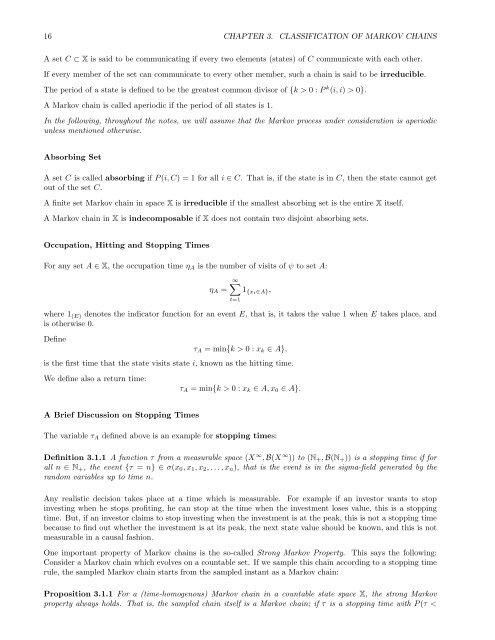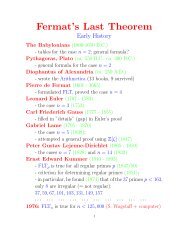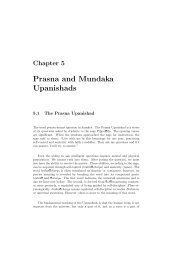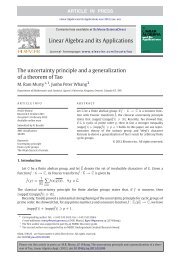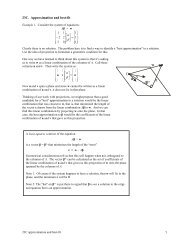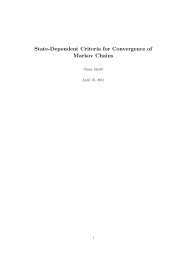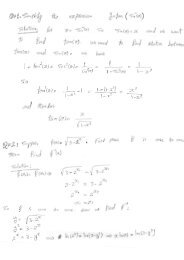Lecture Notes - Department of Mathematics and Statistics - Queen's ...
Lecture Notes - Department of Mathematics and Statistics - Queen's ...
Lecture Notes - Department of Mathematics and Statistics - Queen's ...
You also want an ePaper? Increase the reach of your titles
YUMPU automatically turns print PDFs into web optimized ePapers that Google loves.
16 CHAPTER 3. CLASSIFICATION OF MARKOV CHAINS<br />
A set C ⊂ X is said to be communicating if every two elements (states) <strong>of</strong> C communicate with each other.<br />
If every member <strong>of</strong> the set can communicate to every other member, such a chain is said to be irreducible.<br />
The period <strong>of</strong> a state is defined to be the greatest common divisor <strong>of</strong> {k > 0 : P k (i, i) > 0}.<br />
A Markov chain is called aperiodic if the period <strong>of</strong> all states is 1.<br />
In the following, throughout the notes, we will assume that the Markov process under consideration is aperiodic<br />
unless mentioned otherwise.<br />
Absorbing Set<br />
A set C is called absorbing if P(i, C) = 1 for all i ∈ C. That is, if the state is in C, then the state cannot get<br />
out <strong>of</strong> the set C.<br />
A finite set Markov chain in space X is irreducible if the smallest absorbing set is the entire X itself.<br />
A Markov chain in X is indecomposable if X does not contain two disjoint absorbing sets.<br />
Occupation, Hitting <strong>and</strong> Stopping Times<br />
For any set A ∈ X, the occupation time η A is the number <strong>of</strong> visits <strong>of</strong> ψ to set A:<br />
η A =<br />
∞∑<br />
t=1<br />
1 {xt∈A},<br />
where 1 (E) denotes the indicator function for an event E, that is, it takes the value 1 when E takes place, <strong>and</strong><br />
is otherwise 0.<br />
Define<br />
τ A = min{k > 0 : x k ∈ A},<br />
is the first time that the state visits state i, known as the hitting time.<br />
We define also a return time:<br />
τ A = min{k > 0 : x k ∈ A, x 0 ∈ A}.<br />
A Brief Discussion on Stopping Times<br />
The variable τ A defined above is an example for stopping times:<br />
Definition 3.1.1 A function τ from a measurable space (X ∞ , B(X ∞ )) to (N + , B(N + )) is a stopping time if for<br />
all n ∈ N + , the event {τ = n} ∈ σ(x 0 , x 1 , x 2 , . . . , x n ), that is the event is in the sigma-field generated by the<br />
r<strong>and</strong>om variables up to time n.<br />
Any realistic decision takes place at a time which is measurable. For example if an investor wants to stop<br />
investing when he stops pr<strong>of</strong>iting, he can stop at the time when the investment loses value, this is a stopping<br />
time. But, if an investor claims to stop investing when the investment is at the peak, this is not a stopping time<br />
because to find out whether the investment is at its peak, the next state value should be known, <strong>and</strong> this is not<br />
measurable in a causal fashion.<br />
One important property <strong>of</strong> Markov chains is the so-called Strong Markov Property. This says the following:<br />
Consider a Markov chain which evolves on a countable set. If we sample this chain according to a stopping time<br />
rule, the sampled Markov chain starts from the sampled instant as a Markov chain:<br />
Proposition 3.1.1 For a (time-homogenous) Markov chain in a countable state space X, the strong Markov<br />
property always holds. That is, the sampled chain itself is a Markov chain; if τ is a stopping time with P(τ


